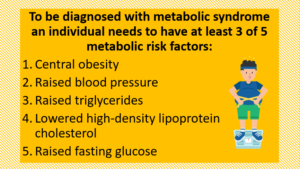Approximately one quarter of the world’s adults have combination of three or more specific risk factors, collectively known as metabolic syndrome, that increase their risk of developing cardiovascular disease and diabetes.
This research will assess the prevalence of metabolic syndrome in people attending community rehabilitation (n=200) and will compare level of health literacy, physical activity levels and dietary intake of those with and without metabolic syndrome.
Aims:
The primary aims of this research are:
- To determine the point prevalence of metabolic syndrome in patients attending community rehabilitation at Eastern Health
- To compare the level of health literacy of people with and without metabolic syndrome
- To compare the physical activity levels of people with and without metabolic syndrome (tri-axial accelerometers/activity monitors).
- To compare the dietary intake of people with and without metabolic syndrome (food frequency questionnaire)
Secondary aims are:
- To assess for associations between patient demographic and clinical factors (age, sex, smoking status, walking speed, number and types of metabolic syndrome risk factors) and primary outcomes.
We hypothesise that prevalence of metabolic syndrome will be higher in community rehabilitation compared to the international average of 25% of adults and that levels of health literacy and physical activity will be significantly lower in people with metabolic syndrome. There may also be differences in macronutrient and micronutrient profiles of participants. Results will impact the way interventions are designed and delivered to manage metabolic syndrome and reduce progression to chronic disease.
Staff involved: Prof Nicholas Taylor, Dr Casey Peiris, Prof Nora Shields (Chris Gilfillan, Judi Porter, Erin Wilson, Katherine Harding)


